Building a safe and comfortable space for your feathered friends is essential for their well-being. An outdoor aviary provides birds with natural sunlight, which is crucial for their health. Sunlight helps convert oils into vitamin D3, supporting bone strength and immune function1.
Choosing the right materials is key. Many standard construction items, like galvanized hardware or pressure-treated wood, can be harmful to birds. Opt for bird-safe options like stainless steel wire and untreated wood to ensure their safety1.
Planning is vital. A well-designed aviary includes features like a catch-hold area to prevent escapes and modular assembly for flexibility. This allows you to adjust the size and shape as needed2.
Taking the time to build a secure and spacious environment will enhance your birds’ quality of life. Learn more about outdoor aviary construction and explore tips for bird-friendly habitats to get started.
Key Takeaways
- Natural sunlight in aviaries supports bird health by producing vitamin D3.
- Use bird-safe materials like stainless steel wire and untreated wood.
- Include a catch-hold area to prevent escapes.
- Modular designs allow for flexible aviary configurations.
- Proper planning ensures a safe and comfortable space for birds.
Design Inspirations and Aviary Benefits
Personal experiences often shape the best aviary designs for bird owners. Many enthusiasts share how their birds inspired unique layouts, from custom perches to interactive toys. These stories highlight the importance of understanding the way your feathered friends interact with their space.
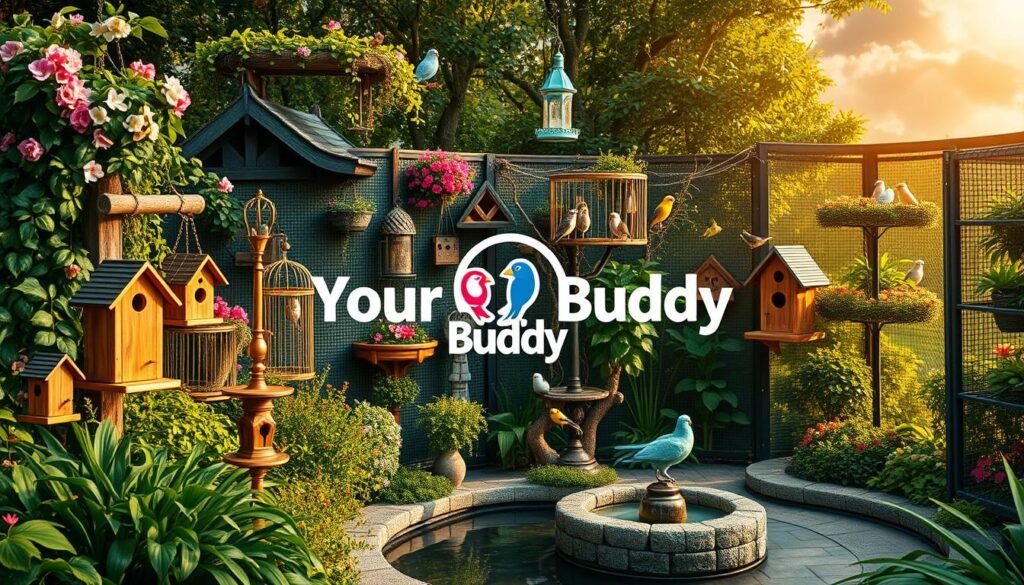
One bird owner shared how their parrot’s love for climbing led to a multi-level aviary with wooden ladders and platforms. Another designed a space with varying textures to keep their finches engaged. These real-life lessons show how thoughtful design can enhance a bird’s happiness and activity levels3.
Personal Bird Stories and Lessons Learned
Designing an aviary often involves trial and error. One owner learned the hard way that spacing between perches matters. Too close, and birds feel cramped; too far, and they struggle to move. By measuring each foot of space, they created a balanced environment4.
Another lesson? Safety first. A hand-crafted wooden frame may look beautiful, but it must be sturdy enough to withstand curious beaks. Adding stainless steel reinforcements ensures durability without compromising aesthetics3.
Understanding Your Birds’ Safety and Happiness
Safety and happiness go hand in hand. Positioning toys and perches at varying heights encourages natural behaviors like climbing and hopping. Including hiding spots reduces stress, while live plants add a touch of nature3.
Studies show that birds in aviaries are 30% more active than those in cages5. This highlights the importance of a spacious, stimulating environment. For more tips on creating a bird-friendly environment, explore our resources.
Planning and Materials Selection
Selecting the right materials is the foundation of a safe and functional aviary. Accurate planning ensures every foot of space is optimized for your birds. Start by choosing durable wood and lumber that can withstand weather conditions and curious beaks6.

Choosing the Right Wood, Wire, and Mesh
Untreated wood is a bird-safe option that avoids harmful chemicals. For the frame, 8 ft-long 2×2 boards provide stability. Pair this with stainless steel wire or galvanized hardware cloth for added safety7.
The right mesh prevents injuries while maximizing visibility. Use ½ by ½-inch wire to deter predators like raccoons and cats7. For smaller birds, 16-gauge wire is ideal, but avoid thinner options to prevent escapes7.
Budget-Friendly Material Tips
Save time and money by sourcing materials strategically. Look for bulk discounts on wire and mesh. Reclaimed lumber can reduce costs while maintaining quality6.
For the frame, ensure every board is measured correctly. A 12-inch concrete slab foundation adds durability and deters digging predators7.
| Material | Purpose | Tips |
|---|---|---|
| Untreated Wood | Frame and Perches | Opt for reclaimed lumber to save costs. |
| Stainless Steel Wire | Safety and Durability | Use 16-gauge for smaller birds. |
| Galvanized Hardware Cloth | Predator Protection | Choose ½ by ½-inch for raccoons and cats. |
Proper material selection ensures your birds enjoy a secure and stimulating environment. For more ideas on creating a bird-friendly space, explore our guide to attracting birds in cold.
Planning Your Aviary Layout and Dimensions
Designing an aviary requires careful thought about layout and dimensions. Proper planning ensures your birds have enough room to fly and explore while maintaining safety. Start by measuring every foot of available space to determine the ideal location.
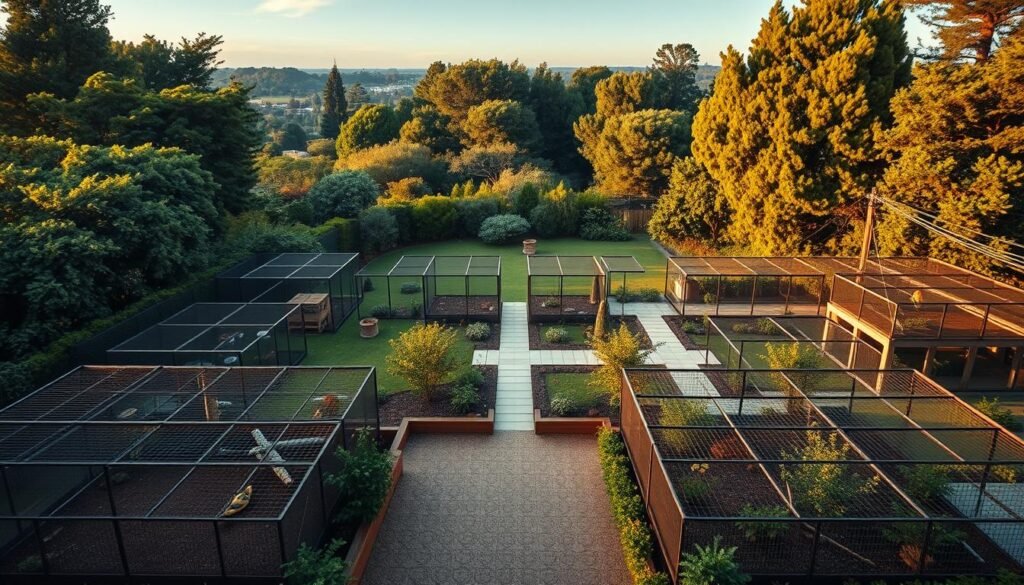
Modular and Versatile Designs
Modular designs offer flexibility, allowing you to resize or reposition the aviary as needed. For example, a 4ft wide x 12ft long x 8ft tall structure can house multiple birds comfortably8. Use untreated wood for the frame and stainless steel mesh for secure boundaries.
Versatile designs also include removable panels for easy cleaning and maintenance. This way, you can adapt the aviary to seasonal changes or new ideas for enrichment9.
Optimizing Space for Seasonal Use
To ensure year-round usability, plan for both covered and open areas. At least one-third of the aviary should be covered to protect birds from harsh weather8. Position the back of the structure against a wall or sheltered spot to reduce exposure to wind and rain.
Incorporate heating elements like 120-watt bulbs for colder months, ensuring the temperature stays above 40 degrees Fahrenheit8. This approach keeps your birds comfortable regardless of the season.
Creating the Perfect Backyard Aviary for Your Birds: What to Consider
Safety and durability are the cornerstones of a well-built outdoor enclosure for birds. Proper mesh selection is critical to prevent injuries and escapes. Use ½ by ½-inch wire to deter predators like raccoons and cats10. Brush off loose burrs from the mesh to ensure smooth edges, reducing the risk of harm to your birds.
When designing the door, make sure it fits securely with minimal gaps. A gap larger than half an inch can lead to escapes or injuries11. Opt for a double-door system to prevent accidental openings. This design adds an extra layer of safety for your feathered friends.
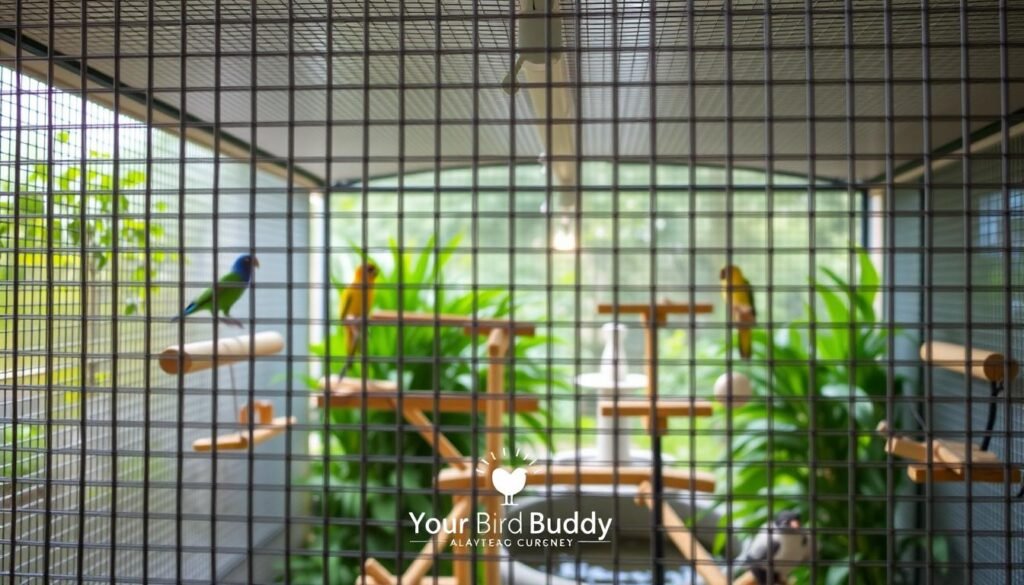
The roof plays a vital role in protecting birds from harsh weather. A sloped design prevents water accumulation, while durable materials like stainless steel ensure longevity10. Ensure the roof is securely fastened to withstand strong winds and predators.
Durability, Maintenance, and Vet Advice
Regular maintenance is essential to keep the aviary in top condition. Inspect wood and wire components monthly for signs of wear or damage. Replace any compromised parts immediately to maintain safety standards12.
Consult a vet for advice on creating a healthy environment. They can recommend specific dimensions and features tailored to your bird’s needs. For example, ensure perches are spaced correctly to prevent overcrowding11.
Use metal fasteners and lumber that meet safety standards. Avoid materials like galvanized hardware, which can be toxic to birds10. By prioritizing safety and durability, you can create a secure and comfortable space for your feathered companions.
Construction Techniques and Step-by-Step Guide
Constructing an outdoor enclosure requires attention to detail and precision. Start by assembling the frame using untreated wood for safety. Measure each foot of space to ensure accuracy. Use stainless steel wire for the mesh, securing it with metal fasteners to prevent gaps13.
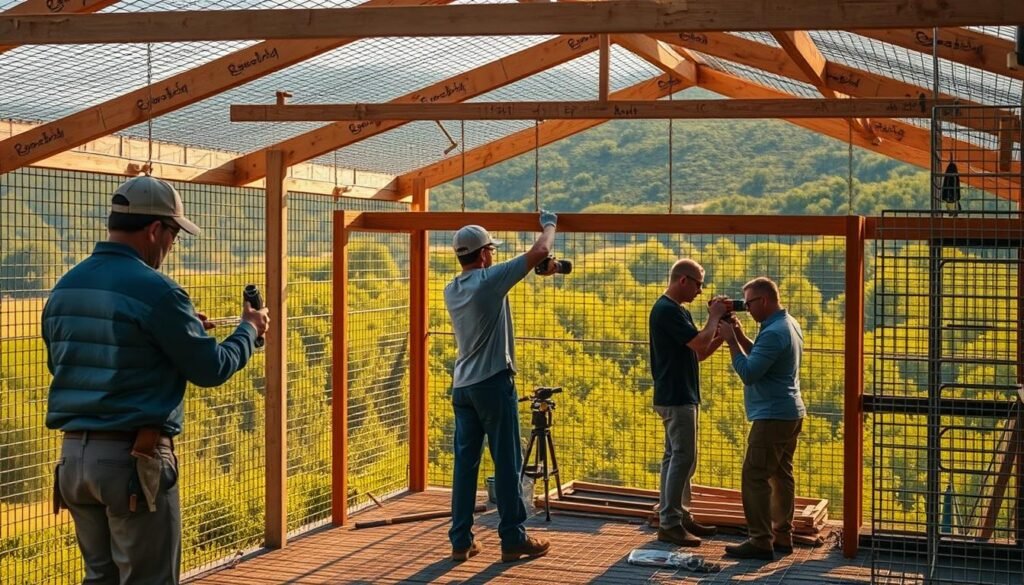
Framing and Mesh Installation Details
Begin by cutting the wood to the desired dimensions. Assemble the frame using screws and lumber. Attach the mesh to the frame, ensuring it’s tightly secured. Use a drill to fasten the wire, leaving no sharp edges14.
Door Construction and Roof Design
Design the door to swing inward, with a gap of 1/8th to 1/4 inch for smooth operation. Install a double-door system for added safety. For the roof, use a sloped design to prevent water accumulation. Attach crossbars for stability13.
Bolting, Drilling, and Assembly Tips
Use bolts to secure the frame and mesh. Drill pilot holes to prevent splitting the wood. Assemble the structure on a flat surface, ensuring all components align perfectly. Add perches and toys to stimulate activity14.
By following these steps, you can create a secure and durable space for your birds. Proper construction ensures their safety and enhances their quality of life.
Integrating the Aviary into Your Outdoor and Indoor Space
Integrating an aviary into your home requires thoughtful planning and design. Whether you’re placing it on a porch or blending it with indoor living areas, the goal is to create a seamless and functional space for your birds. Proper preparation ensures the structure complements your home while providing a safe and comfortable environment for your feathered friends.

Preparing the Porch and Flooring Options
When setting up an aviary on a porch, choosing the right floor is essential. Linoleum or paving are excellent options, as they are easy to clean and durable. These materials prevent bird droppings from seeping into the surface, making maintenance simpler15.
Ensure the floor is level and stable to prevent accidents. Adding a drainage system can help manage water during cleaning. This setup not only enhances safety but also extends the lifespan of the aviary.
| Flooring Option | Benefits | Considerations |
|---|---|---|
| Linoleum | Easy to clean, durable | Requires a smooth surface |
| Paving | Weather-resistant, long-lasting | May need professional installation |
Insulation and Climate Considerations
Climate plays a significant role in the comfort of your birds. Proper insulation ensures the aviary remains warm in winter and cool in summer. Use weather-resistant materials like stainless steel mesh and treated wood to protect against harsh conditions15.
In colder months, consider adding heating elements like 120-watt bulbs to maintain a temperature above 40 degrees Fahrenheit. For warmer climates, ensure adequate ventilation to prevent overheating. Regularly inspect the structure for wear and tear to maintain its integrity15.
Consult a vet for advice on creating a healthy environment. They can recommend specific features tailored to your bird’s needs, such as the ideal spacing for perches and toys. For more ideas on creating a bird-friendly environment, explore our guide to birdwatching and care.
Conclusion
Designing a safe and engaging aviary for your birds involves careful planning and execution. From selecting bird-safe mesh to ensuring proper foot measurements, every detail matters. The right materials, like stainless steel and untreated wood, ensure durability and safety16.
Integrating the aviary into your home or porch requires thoughtful placement and climate considerations. Proper insulation and a secure door system are essential for year-round use17. Adding enrichment items like perches and toys keeps your parrots happy and active.
Regular maintenance and vet check-ups are crucial for long-term success. By following these steps, you can create a space that enhances your birds’ quality of life. Refer to the provided pictures and tips for inspiration and guidance.
With the right ideas and effort, your aviary will become a cherished part of your home. Prioritize safety, comfort, and enrichment to ensure your feathered friends thrive.
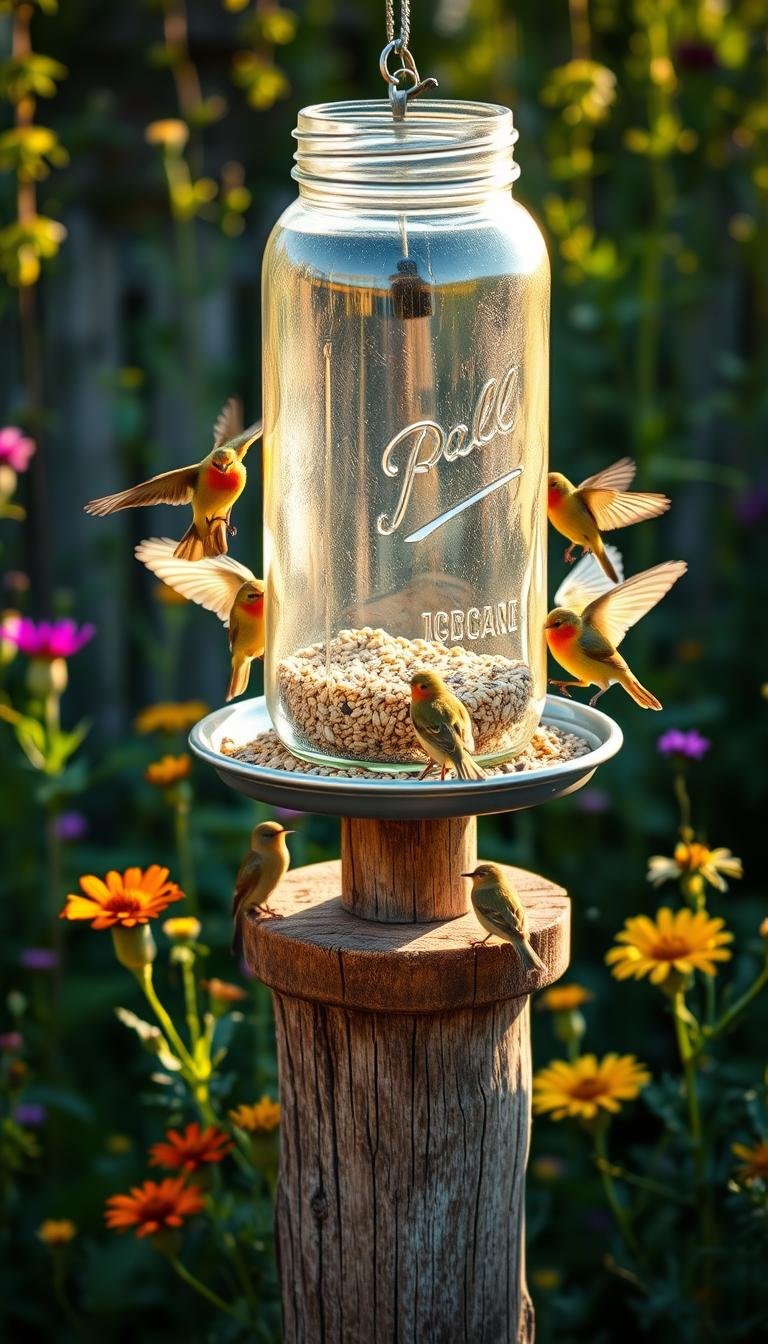
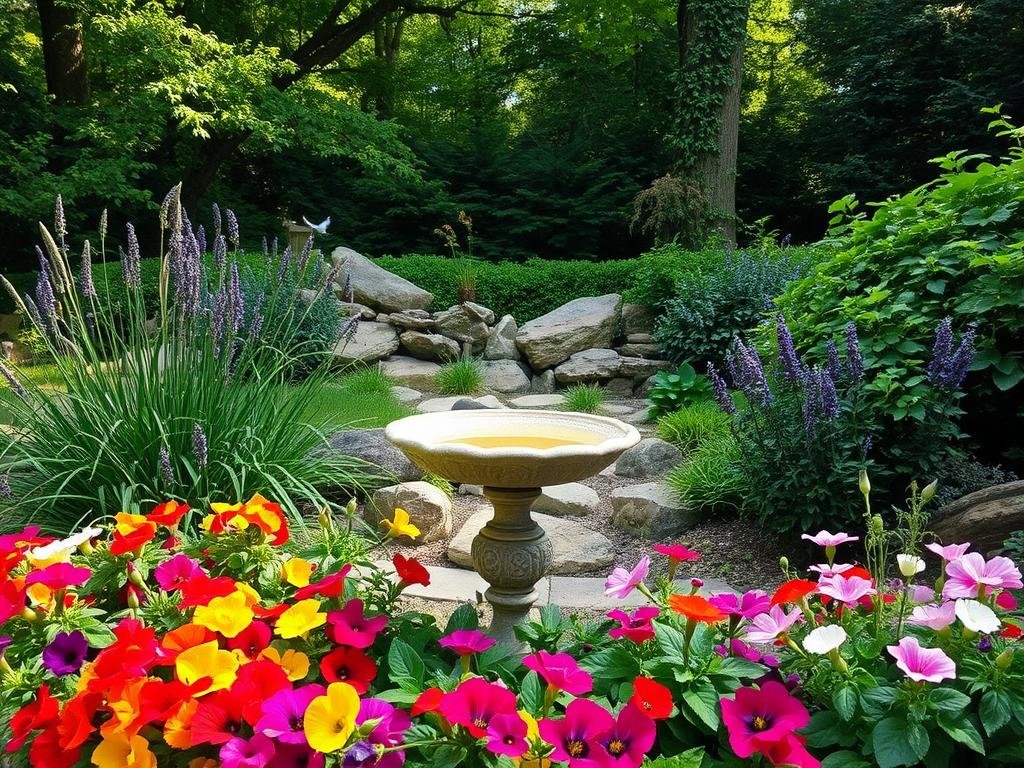

0 Comments